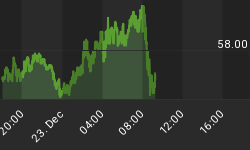The Bureau of Economic Analysis (BEA) recently reported that Q1 GDP was only 0.1% in the United States. Most of that anemic number was blamed on worse-than-usual weather. But it should be noted that if our government accurately accounted for inflation, it would be clear to all that economic growth didn't just stall at the start of 2014; but rather it contracted sharply. And if our economy can be thrown into a tailspin by a few snow storms, it is an economy that simply has not recovered from the Great Recession--which supposedly ended five years ago.
Nominal GDP (Real GDP plus inflation) was reported by the government as 1.4% last quarter. This means that inflation in Q1 was estimated by the BEA to be running at a 1.3% annualized rate. However, according the Bureau of Labor Statistics, energy prices were up 3.3% year-over-year. Food prices as measured by the protein category (meat, poultry, fish, and eggs) were up 6.4% year-over-year. And Health care costs were up 9.9% in the past year--that's the largest increase in health care expenditures in 30 years. Home prices were also up 13% in the past year.
The plain truth is that the cost of living has risen significantly in the past year for anyone accustomed to eating proteins, or anyone seeking to be healthy, or people that use energy, and/or those individuals needing to provide shelter. If those components were correctly weighted in the BEA's inflation index, Q1 real GDP would have been negative. Therefore, taking a more realistic inflation measure off the Nominal GDP print, you can clearly see that the U.S. economy isn't just stuck in neutral, but is shrinking significantly right now. The real figure would most likely close to the minus 2.7% annualized rate it contracted at the start of the Credit Crisis in December of 2007.
The reason why we are in a further period of contraction is that the government never allowed the economy to heal. A period of asset price, money supply and debt deflation is needed to rebalance the economy from the excesses experienced during the last two decades. Instead, the Fed chose to use quantitative easing to re-inflate real estate and stock prices, which also encouraged the public and private sectors to take on debt to a greater extent. This has served to further weaken the American middle class; just as it also increased our wealth gap.
The tapering by the Fed is now halfway done. So we are going to start a new paradigm, which is really a resumption of the old paradigm. Namely, the healing process that began in 2007--the contraction of money supply growth, restructuring of debt and a collapse of asset bubbles.
The Fed will be effectively done with its tapering in the fall. This will once again lead to a healthy period of deflation and recession. Nevertheless, after it dawns of Ms. Yellen that the economy is addicted to QE, she will reverse course and launch another quantitative easing program.
This is because the shocking aspect of the Fed's strategy is that it doesn't grasp how ineffective the QE program is in providing viable and sustainable growth. Yes, massive money printing can send erstwhile falling asset prices higher and also boost the net worth of the wealthy. But it also destroys the purchasing power of the middle and lower classes. And an economy cannot function properly when wealth is unbalanced and concentrated at the very top. QE also prevents the economy from deleveraging, which is a necessary step to promote viable savings and investment. And by not allowing asset prices to fall to a level that can be supported by the free market, more capital is funneled toward the building and servicing of asset bubble, instead of increasing productivity.
As proof of how badly the economy in the United States is struggling, look at the retail sales numbers that were recently released. The following companies that cater to the middle class reported vastly disappointing revenue and earnings: Target, Home Depot, Walmart, Lowe's, Dick's Sporting Goods, PetSmart, Urban Outfitters, Staples, and Sears. And that's just a partial list. This weakness has continued into May, so it has little to do with the weather.
One of the few retailers that beat expectations was Tiffany's. They actually raised their profit forecast on stronger than expected earnings. This best exemplifies how and why the middle class is being destroyed and why this economy cannot grow. You cannot grow an economy in aggregate if you do not have a healthy middle class.
The U.S. economy will never get healthy until we actually address the imbalances that afflict the middle class. This also means the Fed would have to embrace deflation -- at least for a little while. But I have sincere doubts about whether the Fed, or any other developed world central bank, will ever allow that to happen.















